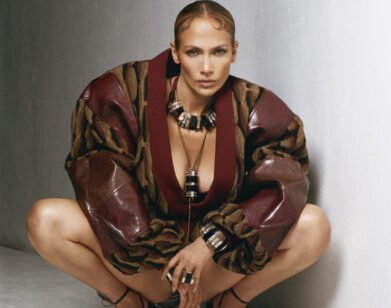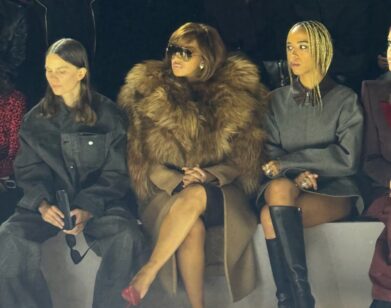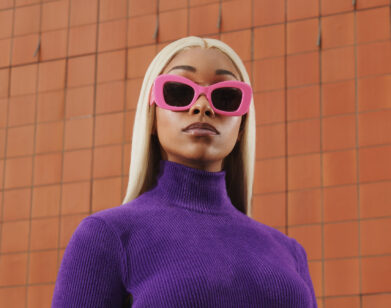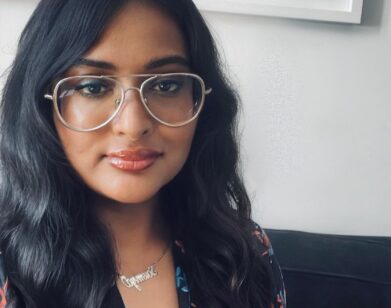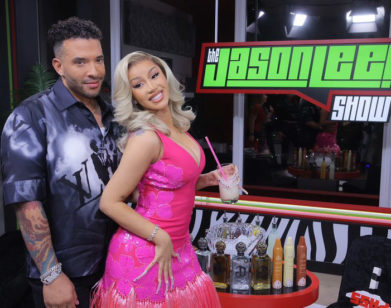Hustlers Director Lorene Scafaria on J-Lo’s Power, Constance Wu’s Eyebrows, and Being Bad on the Pole

Lorene Scafaria with the cast of Hustlers. Photo: Eric Charbonneau.
It’s 2008 and Larry Flynt’s Hustler Club sees its own hit from the stock market crash. The adult cabaret’s most moneyed customers, the superabundant Wall Street suits up the street, are in scarcer attendance, and the ones that remain are stingier, touchier, more pent-up. A few sly dancers from Hustler rise to the recession by “fishing” wealthy types from upscale bars and restaurants back to the club, drugging them, and then running ludicrous tabs on their credit cards—of which they all receive a negotiated percentage.
Around the same time of the Hustler dancers’ rise, a writing trio ascends in Hollywood calling themselves the “Fempire,” three best friends who take the industry by storm. Of the “Fempire,” Diablo Cody collects an Oscar for Juno (2007), Dana Fox brings in a modest $220 million with What Happened In Vegas (2008), and Lorene Scafaria’s Nick And Norah’s Infinite Playlist (2007) steals adolescent hearts and earns back triple its budget.
12 years later, Scafaria helms Hustlers from a script she adapted from a New York Magazine article titled “The Hustlers at Scores,” and debuted the film at the Toronto Film Festival. To play their real-life counterparts, Scafaria assembles a power-house cast—Jennifer Lopez, Constance Wu, Keke Palmer, Lili Reinhart, Cardi B, and Lizzo, to name a few—in a series of power-house roles. Lopez emerges for the first time in the film, ripped from pre-production training, donning a diamond bodysuit that so threatens to disrobe it’s said to have been sewn on just before the scene, and clacking the cash-strewn stage with her nine-inch heels. Scafaria stages iconic images of J-Lo sublimity aplenty, trumping everything else in her peripheries—even the untamed celebrity of Cardi B and Lizzo. This power surfeit in Hustlers dizzies and delights. Interview spoke with Scafaria to learn how she managed it all.
———
AARON HUNT: Do you enjoy this part of the process—talking about it?
LORENE SCAFARIA: It’s the least natural for me. Mostly because I just finished the movie a week and a half ago, so I’m still dreaming about it in a different way. To put it into words this early is really strange. I still can’t wait to show it to people. But yes, it’s so recent.
HUNT: A week and a half ago?
SCAFARIA: Yeah, we finished filming on May 3rd. So it was a really truncated prep, a 29 day shoot, and an incredibly fast post, so the process was very accelerated, but very exciting.
HUNT: Do you think you feel that in the film?
SCAFARIA: It’s definitely on scene. I don’t mind the pressure. I certainly have that kind of energy when I’m doing it. Bursts of energy are all I can really give. I don’t have what it takes for television, that steady pace. I’m definitely more of a sprinter. Even though it had taken many years to make the movie, I’d always said that the only way it got made right was if it got made fast, so ultimately I think that was for the best. It was harder not making the movie, I’ll say that. That was harder for me than making it.
HUNT: Are you anxious without a time constraint?
SCAFARIA: Hustlers was years in the making. I think with something like this that’s not a black and white story, it becomes tempting to want to compromise on the morality of it. I think we all know the difference in right and wrong, so writing is an act of empathy for me, for every character, for everyone navigating a broken value system. I wanted to make the fuller story, and that’s the movie that was harder to get made. It’s also obviously women doing bad things. [Laughs.] There was the unfortunate stigma of strippers and sex workers that got in the way. It felt like these characters weren’t getting judged for where they were then, but from where they started from. It was important to tell this story for a number of reasons, but for me that felt like the most important one.
HUNT: How do you direct power personalities like Jennifer Lopez in roles that magnify their power? Can you, or do you have to step away to let them rule the scene?
SCAFARIA: I met with Jennifer early on to talk about the movie, to make sure we hit it off, saw the scenes in the same way, and got excited to talk about the same things. She’s of course a producer on the film, so we spoke early and often about the script and what we wanted to say. It’s the same movie it was on paper, I’m just lucky I found a group of people that wanted to tell the same story. It was the same thing with Constance—we were very excited to talk about those scenes. Of course her character is so different, and her approach to the world, and all of the other actors approached everything so differently. So you just work with each actor differently. Some people are nervous, some people are extremely comfortable, some are great at improvisation, and some people want to stick to the script. So I like to, especially in those group scenes where the camaraderie and sisterhood is coming to life, keep it open and leave room for everybody to talk over each other and improvise to feel the group dynamic. But they just had it. Keke [Palmer] really is the life of the party and so is Mercedes [Keke’s character]. Constance [Wu] and Jennifer really did have that sisterly relationship. And Lili [Reinhart] really is the heart of the set—so sweet, talented, and funny. Of course, Jennifer and Cardi have great chemistry, and Cardi and Lizzo have such great personalities that I really wanted to let them shine.
But the beauty was getting all of these different people in one room, these women that I’m a fan of and come from all these different forms of entertainment. Some are actors, some are singers and performers, others are dancers, strippers, and stand up comedians, so to watch them all play off each other was a beautiful thing.

Scafaria with Lopez on the set of Hustlers.
HUNT: Did the cast have a heavy influence on their character’s visualization from the wardrobe up?
SCAFARIA: Certainly, it’s a very collaborative process. Especially in this where some of the wardrobe has, um, less fabric than others, you want to make sure they’re extremely comfortable in what they’re wearing. So the actors all had communication with Costume Designer Mitchell Travers, who is a brilliant artist, and I about it. But it’s a highly curated wardrobe. We’re trying to capture a period in very recent history. Fashion is very different, even when you’re only looking back 12 years. So I was a stickler about every piece of clothing, production design and wardrobe alike.
We had such a large cast and such a quick schedule that, if it weren’t for our New York crew led by Mitchell, things could have gone out of hand pretty quickly. Mitchell would send me pictures from every wardrobe fitting, and him, the actor, and I usually ended up liking the same thing. My one instruction to him was that I didn’t want any green in the movie except for money. I wanted to stay away from green other than cash.
HUNT: Did you have any sort of rehearsal period or bonding exercises with the cast to build an authentic sense of their camaraderie?
SCAFARIA: A lot of it was on the page. Constance and Jennifer went through a lot of work ahead of time to get into the head of their character and the time period. Constance tweezed her eyebrows back to 2007 and Jennifer carried that rhinestone lighter in her hand 24 hours a day and trained on that pole so hardcore for months at a time. Each of them had their own intense process to get into the role. Keke and Lili took pole dancing lessons together and had their own little bonding session there. Of course they’re adorable on and off screen. Constance and I spent a lot of time together. We took a liquid motion class, which is basically floor work, everything but pole. I am not good on the pole, obviously.
I didn’t get to see Constance and Jennifer together until the camera test. Both of them were there together in hair and makeup for the first time. There they are eating, Jennifer has her fur coat on and put her arm around Constance and I just got chills. It was everything I dreamt of. I’d thought of them individually in their characters, and they had that big sister-little sister chemistry immediately. Jennifer is very maternal and is kind of the mama bear of the set. So I think that since everyone filled their roles so well, it sort of just happened right away. It’s hard to fake that.

A still from Hustlers.
HUNT: That iconic image of Destiny (Constance Wu) draped under the wing of Ramona’s (Jennifer Lopez) fur coat…
SCAFARIA: That was the first scene I wrote and the last scene we shot. That was always the scene that sealed their friendship immediately. We see Destiny have contact with Ben and strangers, and certainly she has a relationship with her grandma, but we don’t see her in contact with the other girls and friendships. So Ramona inviting her into her own coat was always that immediate intimacy that I think only girls can have with each other.
HUNT: Why do we see the film through Destiny’s perspective? Is it important that we view Ramona’s power on the pedestal Destiny sees her on, to keep Ramona and her mysticism at arms length?
SCAFARIA: It’s a story about Ramona through Destiny’s point of view. So it’s very much about their friendship. But it’s certainly that mentor-mentee, big sister-little sister, mother-daughter kind of relationship. Destiny starts in complete awe of her when she sees her dance for the first time, having money showered over her. She wants to know her secrets and learn how she does it. I think she also senses that she’s in control. She has power up there, she has agency, and she wants that independence. She wants and very much needs that feeling, so she goes in search of that.
There is a mythology around Ramona from Destiny’s point of view and I think there’s a mythology around Jennifer Lopez. It’s part of the allure of seeing her in this role, knowing what she’s done with her life and accomplished. As successful and incredible as she is, she’s been underestimated. There’s something really fun about putting the audience in that same awe that Destiny is in.
I don’t think it starts in the same place for Ramona, obviously. She’s a more seasoned stripper. Strippers do tend to work together in teams or pairs. It’s more lucrative, but there’s also that safety in numbers and that camaraderie that forms. I think that love she has for Destiny even takes her by surprise. This relationship they had with each other is incredibly pure and obviously goes through a lot of different twists and turns on the way, but it starts in such a pure place. For Destiny, it’s that immediate intimacy that she didn’t have moments before. But when you see the two of them in the same coat, you understand why it’s them against the world.


